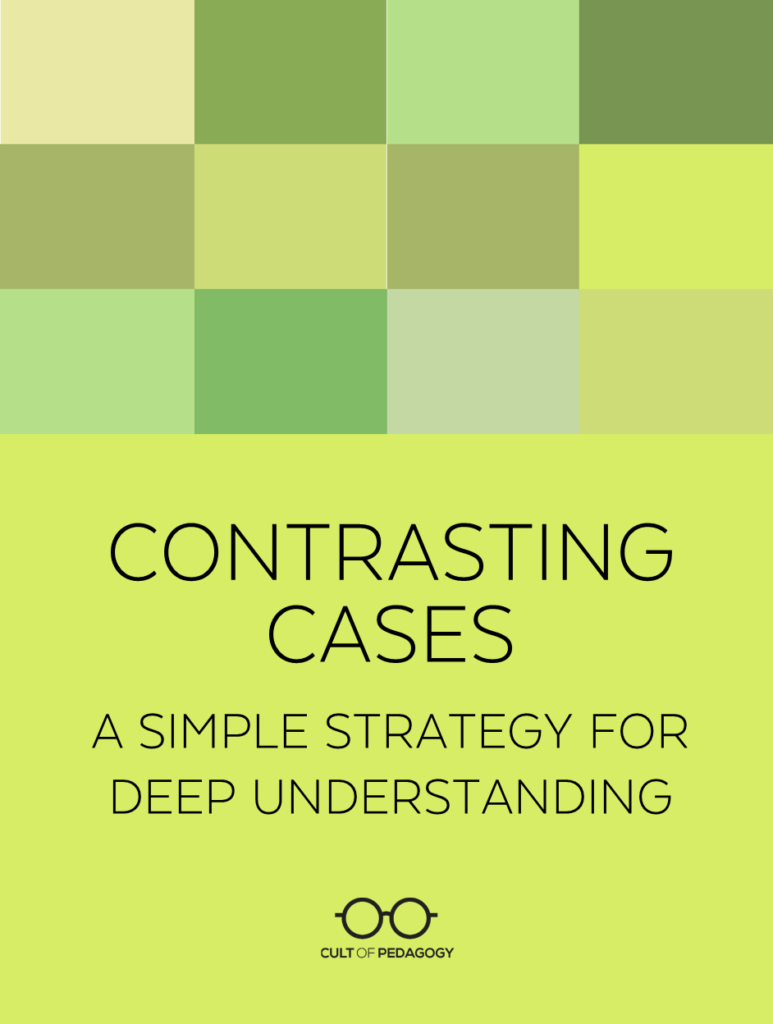
Listen to the interview with Sarah Levine:
Sponsored by Listenwise and Read&Write by Texthelp
This page contains Bookshop.org links. When you make a purchase through these links, Cult of Pedagogy gets a small percentage of the sale at no extra cost to you. What’s the difference between Amazon and Bookshop.org?

When I ask my students what color this is, most of them say “green.” Then I contrast that green with similar colors, and ask them, “How would you describe the color now?”

Then kids generally shift to more specific descriptors like “dark green,” “forest green,” or “emerald green,” and they add names for the other kinds of green they see.
This shift occurs because it’s easier to understand the characteristics of a thing when you contrast it with other things that are just slightly different (Gentner; 1999; Schwartz, 2016). Cognitively speaking, contrasting similar things activates and helps add to your mind’s map (also called a schema) of those things, which helps you recall more details, make more connections, and develop more general rules about what something is or how it works.
This is why, when someone asks you a broad question like “How would you define learning?” or “What is learning?” you might draw a blank or go to vague generalizations. But let’s say someone asks, “How did you define learning 10 years ago, and how do you define it now?” or “How would you compare learning to ride a bike and learning to write a paper?” or even “What’s a bad definition of learning compared to a better one?” Depending on the contrasting case, you will think more specifically about different parts of learning. You will generate more ideas and maybe make insights you would not otherwise have made.
Contrasting cases is a valuable tool for any cognitive work—in any subject area—that involves going beyond surface traits and considering deeper connecting principles, or reflecting on specific features of a thing. You can read a really helpful introduction to this approach in Schwartz et al.’s book, The ABCs of How We Learn.
Here are a few examples of what this approach looks like in different disciplines:
- writing instruction: Having students compare pieces of writing at different levels of proficiency improves the writing they produce (Lin-Siegler et al., 2015).
- math: Having students compare two or more ways of solving a problem improves their procedural knowledge and problem-solving flexibility (Rittle-Johnson & Star, 2007).
- science: Comparing similar structures in organic chemistry and phenomena in physics helps students strengthen their conceptual knowledge (Chin et al., 2016; Graulich & Schween, 2018).
In my field of study, literary interpretation, using contrasting cases is especially useful to help students enrich their reading experiences and build interpretations of many kinds of texts, including fiction, poetry, or political speech. But you can use this approach in any subject where you’re studying rhetorically powerful texts, like advertisements, headlines, art, primary historical documents, and film.
In this post we’ll drill down specifically to using contrasting cases for language study. I’ll show you three variations of this approach: (1) Synonym Scale, (2) There and Not There, and (3) Bare Bones vs. Dressed Up.
1. SYNONYM SCALE
Let’s say you’re teaching about climate change in a science class, or propaganda in a social studies or English language arts class. You are interested in having students consider the rhetoric around climate change. Maybe you start by asking them to focus on the common phrase global warming, and you ask them how that phrase might affect public understanding of climate change.
As a teacher, you probably already have a mental framework, or schema, for language about climate change, so you already know other phrases people use to describe climate change (like extreme weather or climate crisis). Because of this knowledge, you are probably already using contrasting cases when you consider the rhetorical effects of the term global warming. So you might already have in mind that, compared to other terms, the phrase global warming could make climate change seem less urgent than it is, or might make people think positively about it, since people like to be warm.
But in many cases, our kids don’t yet have those schemas to draw from. And it’s really hard to think about the effects of something in isolation. So when you ask how global warming might affect public understanding of climate change, your kids might say kind of obvious things like, “The phrase global warming will remind people that the earth is getting warmer,” Or “it will make them think about how the globe is changing.” Here is where you can use contrasting cases to help students build their schema and better understand how language can work to mislead, manipulate, rally people to action, and more.
First, look for synonyms that help highlight the ideas you are interested in exploring. If you want to help your kids think about rhetorical effects, you’ll look for synonyms that highlight or downplay the urgency of climate change. You can draw on your own and your students’ knowledge, or go the interwebs for possibilities. For example, after a quick synonym search, I chose mild and extreme synonyms like climate change, climate emergency, climate fluctuation, climate arson, extreme weather, increase in average temperature, and global heating.
When you share these synonyms with students (and ask them to contribute more), they can better conceive of and articulate the effects of the original phrase, as well as all the others, and further understand tone, connotation, symbolic meaning, and other aspects of textual and rhetorical interpretation that contribute to people’s understanding of science. You can offer them sentence stems that help them articulate these effects, if you like.
Next, you can teach kids to put synonyms on a scale anchored by positive effects on one side and negative effects on the other (a similar approach is used in Up-Down-Both-Why). In pairs or groups, kids can debate the order of those terms (like, is warming more alarming than heating?) based on their interpretations of the terms’ connotations. They can also consider how context matters (positive for whom? negative effects on what?), how familiarity with a term might diminish its impact, or how different words suggest different levels of agency or blame.

The strategy is especially useful for helping students understand the relationship between language and power.
- For example, try contrasting carefully chosen synonyms for “woman” as more positive or more negative can help students think about gender, power, and language: female, muñeca, gal, doll, woman, broad, sister, lady, chick, señora, chica.
- Contrasting recent news headlines about political or social issues can help students reason about bias more generally, as with this comparison of the left and the right’s framing of Florida’s “Don’t Say Gay” bill.
Contrasting cases works beyond individual words and phrases. You can compare whole essays, poems, short stories, or news articles to help students develop general criteria for writing, or see nuances in authors’ choices. For example:
- If you want kids to identify the conventional features of a college essay, show them a bunch that all have the same fundamental elements. Ask them to see what the essays have in common. By identifying those commonalities themselves, they are more likely to remember and be able to implement them, as compared to you listing the elements or showing them just one example of a good essay.
- Let’s say you want to help kids explore the effects of some aspect of personal narrative writing, such as descriptive imagery. Write 3 to 5 short beginnings or endings that are all about the same topic, but are different because they have too little or too much detail, strong verbs and weak verbs, and so on. Ask students to debate which narrative works best or is most powerful, and why.
- Contrasting several translations of a text can help students explore the nuances of each, and the effects of particular authorial choices. Many language teachers do this kind of work already. In my ELA classroom, many students speak Spanish and English, while some others speak only English. In a unit on versions of love, all my students looked at two translations of Pablo Neruda’s “Tonight I Can Write (The Saddest Lines).” The multilingual students discussed which translation they felt best captured the meaning and tone of the original. The English-only students learned from their classmates and were still able to compare the two translations and explain which they felt worked better for them. I usually look online for texts with more than one translation, like this one with a bunch of translations of Neruda, or these contrasting translations of a poem by Wang Wei. Also, this book contains a number of poems in different languages with several English translations each.
2. There and Not There
If you’d like kids to think about the effects of specific authorial moves, you can use contrasting cases to present the original version alongside one where you’ve gotten rid of those moves. Then your students can compare the “there” and “not there” versions. Doing this helps students interpret and maybe even more deeply appreciate or critique the effects of the original.
For example, consider an excerpt from Martin Luther King’s classic speech, “I Have a Dream.” Let’s say you want students to reflect on the effects of King’s use of repetition in the text:
But one hundred years later, the Negro still is not free. One hundred years later, the life of the Negro is still sadly crippled by the manacles of segregation and the chains of discrimination.
But if you ask kids, “What are the effects of this repetition?” they may say something like “It really helps you see how many years later it is,” or “It makes you see how things are still the same after all this time.” Both of those observations are valuable. But again, it’s really hard to comment on the effects of something without being able to compare a rich stock of examples that are already in your head.
Try getting rid of the repetition and asking your kids which speech seems more effective, moving, persuasive, and so on.
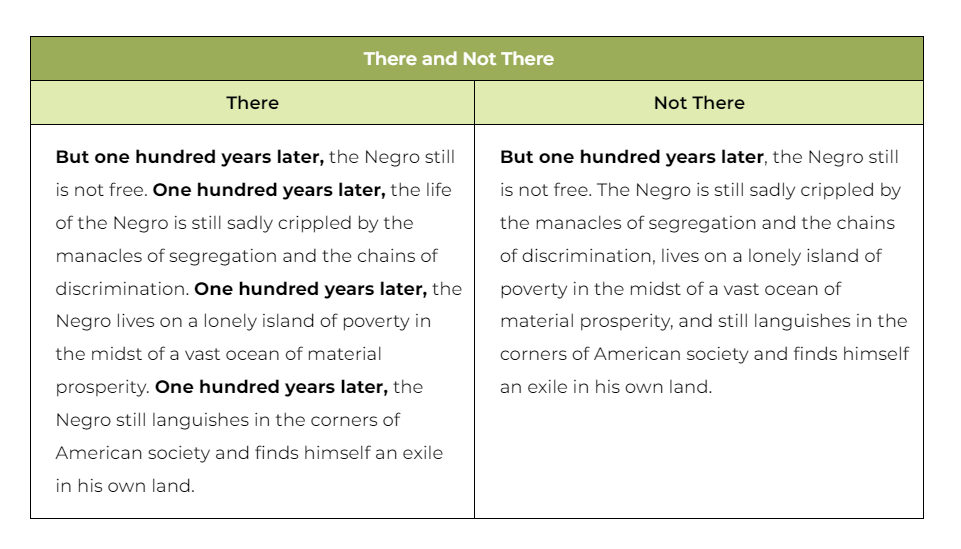
The comparison gives kids more to work with. When I have done this with my students, one or two kids usually say they prefer the shorter speech—it’s more efficient. Or I myself make that argument. Then other kids can counter with their interpretations of the effects of the structure of the speech, which means they are building an interpretation for a reason—to help someone else see what language can do.
3. Bare Bones vs. Dressed Up
In another version of contrasting cases, you can help your kids learn to boil a text down to its essence, and then compare it to the original to better understand the effects of the original. This approach works well with longer pieces of literature, essays, or speeches. For example, I asked my students to try to articulate the essence of Toni Morrison’s Beloved. One wrote, “Slavery is really, really awful, and it can ruin you, and you have to be super strong to find yourself even after you’ve escaped.”
This student captured the essence of the book really well. But if you can capture the essence of the book so well, what’s the rest of the book doing? Why not just read that theme statement and skip the novel?
You can use contrasting cases to have students explore how authorial moves and specific details of a story contribute to the overall effects and themes. With Beloved, for example, you can compare the addition of each event, each setting, each character, and each turn of phrase to the bare bones version of the text. What does the ghost of Beloved actually add to the story? How does it help a reader feel and think? Why include the setting of 124? What does that add to the bare bones of the story? And so on.
Or back to the college essay. No matter the particulars, every essay is essentially saying, “Take me!” If you ask your students to compare the bare bones version of an essay with other dressed up versions, you can help them evaluate the effects of different features, like sentence structure, tone, or specific narrative choices.
Here are some final sentences of college essays (no room here for entire essays). I made them up with a particular purpose: to have kids think about the effects of tone and specificity in different endings. Along with the bare bones version, I created a generic version that is also kind of humble (#1), a detailed one that seems to connect with a story told in the body of the essay but is not as humble (#2), and one using an arrogant and inadvisable tone (#3). Kids will probably think all of them are pretty cheesy. Some will point out that the bare bones version might actually do the job. Either way, students can contrast them based on how well they paint a picture, how humble they are, or other criteria you choose. They will develop more sophisticated understandings of writing for effect, and they will build up the schemas that good readers and writers need.
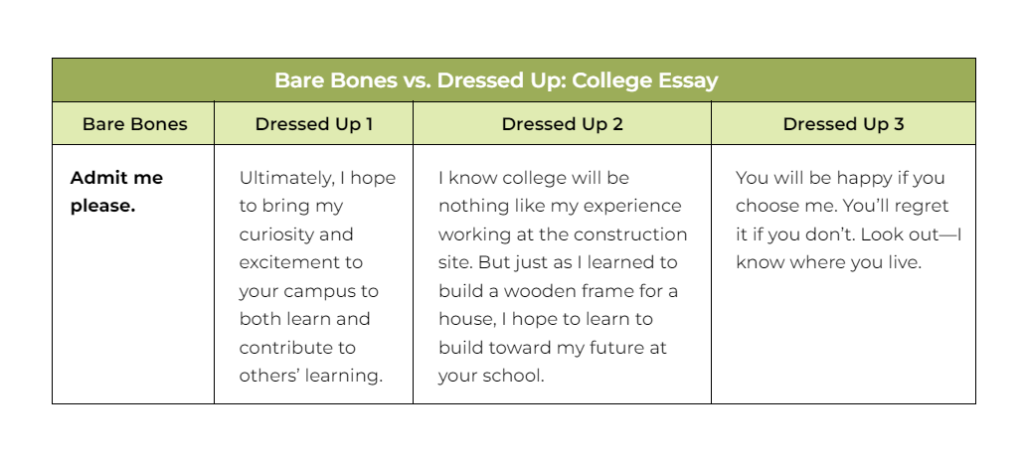
When students are working on their own college essays, contrasting cases can work as a writing tool. Have them write terrible versions and then revise.
There are many ways to tweak contrasting cases for your kids. The big take-aways are: 1) It’s easier to think about the effects of a thing if you can compare it to other, similar things; 2) Contrasting cases allow you to see underlying rules and big ideas; and 3) You create contrasting cases by finding or creating examples that differ in one important way: different solutions to the same math problem, different photographs of the same subject; different headlines about the same event. When we want our kids to do deep and critical thinking, let them contrast different examples. One is often not enough.
References
Chin, D. B., Chi, M., & Schwartz, D. L. (2016). A comparison of two methods of active learning in physics: inventing a general solution versus compare and contrast. Instructional Science, 44(2), 177–195. https://doi.org/10.1007/s11251-016-9374-0 [PDF]
Gentner, D., & Namy, L. L. (1999). Comparison in the development of categories. Cognitive Development, 14(4), 487–513. https://doi.org/10.1016/S0885-2014(99)00016-7
Graulich, N., & Schween, M. (2018). Concept-Oriented Task Design: Making Purposeful Case Comparisons in Organic Chemistry. Journal of Chemical Education, 95(3), 376–383. https://doi.org/10.1021/acs.jchemed.7b00672
Lin-Siegler, X., Shaenfield, D., & Elder, A. D. (2015). Contrasting case instruction can improve self-assessment of writing. Educational Technology Research and Development, 63(4), 517–537. https://doi.org/10.1007/s11423-015-9390-9 [PDF]
Rittle-Johnson, B., & Star, J. R. (2007). Does comparing solution methods facilitate conceptual and procedural knowledge? An experimental study on learning to solve equations. Journal of Educational Psychology, 99(3), 561. [PDF]
Schwartz, D. L., Tsang, J. M., & Blair, K. P. (2016). The ABCs of how we learn: 26 scientifically proven approaches, how they work, and when to use them. W. W. Norton & Company.
Join our mailing list and get weekly tips, tools, and inspiration that will make your teaching more effective and fun. You’ll get access to our members-only library of free downloads, including 20 Ways to Cut Your Grading Time in Half, the e-booklet that has helped thousands of teachers save time on grading. Over 50,000 teachers have already joined—come on in.


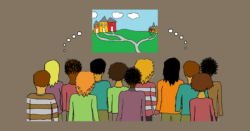
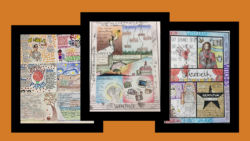

As an English teacher, I can definitely see this strategy as a beneficial addition to my poetry unit. It provides a “way into” the conversations about poetry for my students who see it as confusing or intimidating. Also, I could see the usefulness of this strategy in upper-level English courses to encourage students to analyze the significance of specific words and phrases in all forms of literature and nonfiction as well.
I think this strategy has so much potential in an ELA classroom. Especially for younger students, having a specific structure or framework to work off of is much easier and more impactful than trying to draw answers out of thin air. I really think this theory goes hand in hand with the idea of mentor texts, and how students can really thrive when they get to work with a concrete example of what to do, what not to do, or what to remember.
I really enjoyed learning about this approach to creating deeper understanding for students. I think we are living in a time where words really matter, and the words we choose to use illicit feelings and reactions we sometimes don’t even intend. I think this approach gets students to consider their word choice in various situations, along with deepening their understanding of various topics. I think many educators are taking a social approach to teaching; meaning we are encouraging our students to think beyond their textbooks and thinking of ways we can best help the world in which we live. Contrasting cases is a very helpful way to get students thinking, and allows to create wonderful discussions about many different topics.
We’re glad to hear that you find value in this approach, Kristen!